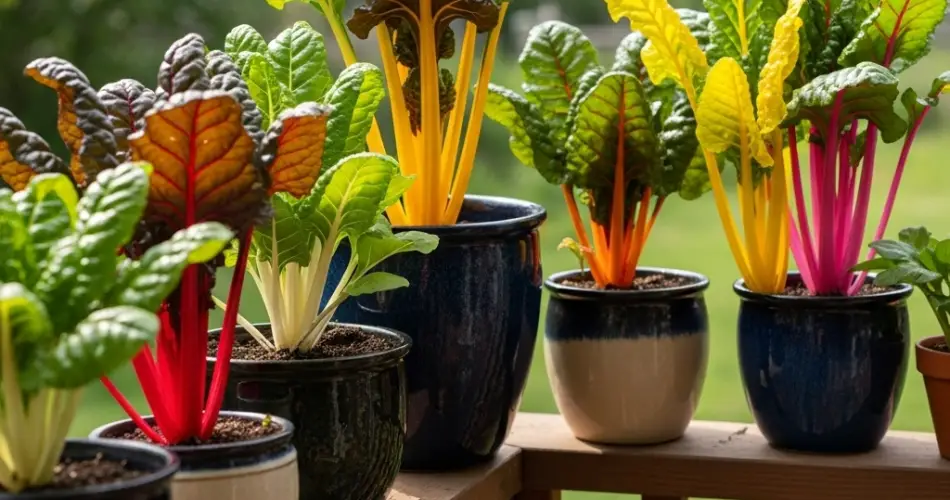Swiss chard is one of the most colorful, nutritious, and beginner-friendly leafy greens you can grow at home. With its vibrant stems in shades of red, yellow, orange, and pink, and lush green leaves, it adds beauty and bounty to any small-space garden. Even if you’re new to gardening, Swiss chard thrives in containers and requires minimal effort to cultivate—making it a perfect choice for balconies, patios, or kitchen windowsills.
This hardy and versatile vegetable is packed with vitamins A, C, and K, and minerals like magnesium and iron. Whether you want to sauté it, use it in soups, or add color to salads, growing Swiss chard in pots is a rewarding and straightforward experience.
Why Swiss Chard is Ideal for Pots
Swiss chard is a fantastic choice for container gardening due to its adaptability and resilience. Here are a few reasons why it’s beginner-friendly and pot-appropriate:
-
Shallow-rooted: Does not require deep soil to grow well
-
Heat- and cold-tolerant: Can be grown in multiple seasons
-
Colorful: Adds ornamental value to your garden
-
Continuous harvest: Produces over a long period if harvested properly
-
Low-maintenance: Doesn’t need constant care to thrive
Even with limited space and time, you can enjoy homegrown greens packed with flavor and nutrition.
Choosing the Right Variety
Several varieties of Swiss chard do well in containers. Consider these popular choices:
-
Bright Lights: A mix of colorful stems, highly decorative and tender
-
Fordhook Giant: Large, crinkly green leaves and thick white stems; highly productive
-
Ruby Red (Rhubarb Chard): Deep red stems and dark green leaves; great for cooking
All varieties grow well in pots, but for visual interest and variety, the colorful types like ‘Bright Lights’ are especially appealing for small gardens.
Materials You’ll Need
To grow Swiss chard in pots, gather the following supplies:
-
A pot at least 8–10 inches deep and wide (larger pots allow for more plants)
-
High-quality potting mix enriched with compost
-
Swiss chard seeds or seedlings
-
Watering can or spray bottle
-
A sunny location (4–6 hours of sunlight per day)
-
Optional: organic fertilizer or compost tea
Ensure your pot has drainage holes to prevent water accumulation, which can lead to root rot.
Planting Swiss Chard in Pots
-
Prepare the Pot
Fill the container with moist potting mix, leaving about 1 inch from the rim. Mix in compost to enrich the soil. -
Sow the Seeds or Plant Seedlings
-
Plant seeds ½ inch deep, spaced about 3–4 inches apart.
-
If using seedlings, gently transplant them at the same spacing.
-
Water gently after planting.
-
-
Thin the Seedlings
Once seedlings grow 2–3 inches tall, thin them to about 6 inches apart. Use scissors to snip extras rather than pulling to avoid disturbing roots.
Caring for Your Swiss Chard
-
Sunlight: Place the pot where it receives at least 4–6 hours of sunlight daily. Chard tolerates partial shade but thrives in bright light.
-
Watering: Keep the soil consistently moist but not soggy. Water when the top inch feels dry.
-
Feeding: Every 2–3 weeks, apply diluted organic fertilizer or compost tea to encourage lush leaf growth.
-
Mulching: A light layer of mulch helps retain moisture and reduces the need for frequent watering.
Swiss chard grows best in mild temperatures but tolerates both warm and cool conditions. In warmer climates, provide afternoon shade to prevent stress.
Harvesting Swiss Chard
Swiss chard can be harvested as soon as the outer leaves are about 6–8 inches long—usually within 4–6 weeks of planting.
-
Cut Outer Leaves: Use scissors or garden shears to snip mature outer leaves, leaving the center intact so new growth continues.
-
Frequent Harvesting: The more you harvest, the more the plant will produce. Don’t harvest more than one-third of the plant at a time.
You can enjoy multiple harvests from the same plant for several months with proper care.
Common Issues and Solutions
Swiss chard is generally pest- and disease-resistant, but here are a few things to watch for:
-
Aphids: Spray with a gentle stream of water or use neem oil to remove them.
-
Leaf miners: Look for squiggly lines in leaves; remove and discard affected foliage.
-
Fungal spots: Avoid overhead watering and ensure good air circulation.
Most problems can be prevented with regular monitoring and good hygiene practices.
Tips for Success
-
Grow several plants in a wide container for a fuller harvest.
-
Rotate the pot every few days for even sun exposure.
-
Refresh the soil with compost between plantings for continuous productivity.
-
Combine Swiss chard with herbs like parsley or basil in the same container for a diverse mini garden.
Final Thoughts
Swiss chard is a beautiful, nutrient-dense green that’s incredibly easy to grow—even in small pots. Its resilience, ornamental appeal, and long harvesting period make it an ideal choice for beginners and urban gardeners alike. With just a little sunlight, regular watering, and occasional feeding, your container-grown Swiss chard will reward you with vibrant leaves for weeks or even months. Start your pot gardening journey today, and enjoy the satisfaction of harvesting your own fresh greens from right outside your door.



